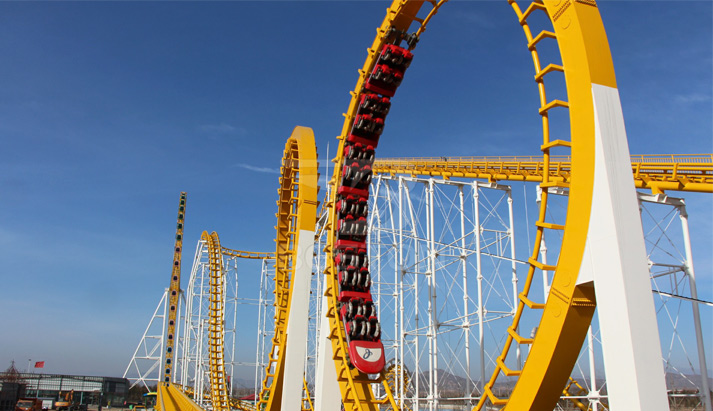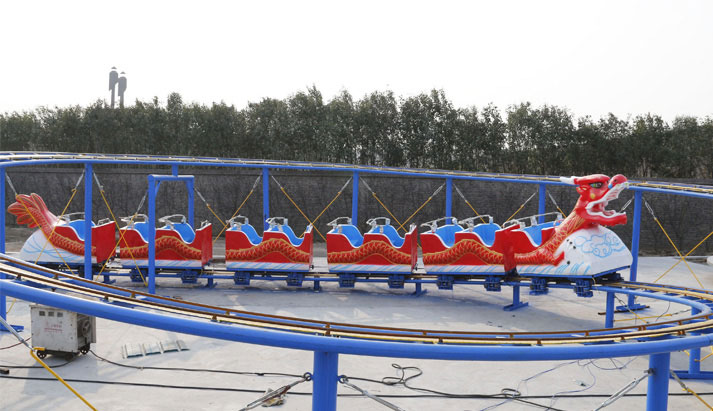Roller coasters, the epitome of thrill rides, come in all shapes and sizes. From towering giants that dominate the skyline to compact wonders nestled in amusement parks, each roller coaster offers a unique experience. This article delves into the distinctions between small and large roller coasters, exploring aspects such as design, thrill factor, and rider experience.
Size and Scale
The most apparent disparity between small and large roller coasters lies in their size and scale. Large roller coasters often feature towering structures, reaching staggering heights and covering vast expanses of land. In contrast, small roller coasters are characterized by their compactness, occupying relatively modest footprints within amusement parks. The size discrepancy directly influences factors such as ride duration, speed, and intensity.

Design and Layout
Large roller coasters typically boast intricate and elaborate designs, incorporating multiple inversions, steep drops, and complex track layouts. These coasters often utilize advanced engineering techniques to create gravity-defying maneuvers, such as corkscrews, loops, and barrel rolls. On the other hand, small roller coasters prioritize simplicity and efficiency in their design, featuring more straightforward layouts with fewer elements. While they may lack the complexity of their larger counterparts, small coasters excel in delivering smooth and family-friendly experiences.
Thrill Factor
When it comes to sheer thrill, large roller coasters reign supreme. Their towering heights and blistering speeds generate adrenaline-pumping sensations that leave riders breathless. The combination of steep drops, high G-forces, and rapid acceleration creates an exhilarating experience that is unmatched by smaller coasters. In contrast, small roller coasters offer a milder thrill, catering to a broader audience, including families and younger riders. While they may not deliver the same intensity as large coasters, small rides provide an enjoyable introduction to the world of roller coasters to buy.
Rider Experience
The rider experience varies significantly between small and large roller coasters. Large coasters often feature immersive themes, elaborate queue lines, and special effects that enhance the overall experience. Riders are treated to panoramic views from towering heights, adding an element of spectacle to the thrill. In contrast, small roller coasters focus on simplicity and accessibility, providing a quick and exhilarating ride without the frills. While they may lack the grandeur of their larger counterparts, small coasters offer a classic amusement park experience that is timeless and nostalgic.

Accessibility and Appeal
Large roller coasters cater to thrill-seekers and enthusiasts seeking the ultimate adrenaline rush. Their imposing presence and record-breaking statistics draw crowds from far and wide, making them iconic attractions within amusement parks. However, the intensity and height restrictions may deter some riders, limiting their accessibility to a specific demographic. In contrast, small roller coasters appeal to a broader audience, including families, children, and individuals seeking a more relaxed experience. Their modest size and gentle thrills make them suitable for riders of all ages and comfort levels, ensuring widespread appeal within amusement parks.
Maintenance and Operational Considerations
Maintaining and operating large roller coasters requires significant resources and expertise due to their intricate design and massive scale. Regular inspections, routine maintenance, and adherence to strict safety protocols are essential to ensure the continued operation of these attractions. In contrast, small roller coasters are generally more straightforward to maintain and operate, requiring fewer resources and manpower. Their compact footprint and simplified design contribute to lower operating costs and increased efficiency, making them attractive options for amusement park operators.
In conclusion, the disparity between small and large roller coasters extends beyond mere size, encompassing design, thrill factor, rider experience, accessibility, and operational considerations. While large coasters offer unparalleled thrills and spectacle, small coasters provide a charming and accessible alternative for riders of all ages. Whether towering over the skyline or tucked away in a corner of the park, roller coasters continue to captivate and delight audiences worldwide with their exhilarating rides and timeless appeal in www.bestonamusementrides.com.